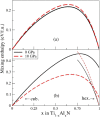Phase Stability and Elasticity of TiAlN
- PMID: 28824159
- PMCID: PMC5448856
- DOI: 10.3390/ma4091599
Phase Stability and Elasticity of TiAlN
Abstract
We review results of recent combined theoretical and experimental studies of Ti1-xAlxN, an archetypical alloy system material for hard-coating applications. Theoretical simulations of lattice parameters, mixing enthalpies, and elastic properties are presented. Calculated phase diagrams at ambient pressure, as well as at pressure of 10 GPa, show a wide miscibility gap and broad region of compositions and temperatures where the spinodal decomposition takes place. The strong dependence of the elastic properties and sound wave anisotropy on the Al-content offers detailed understanding of the spinodal decomposition and age hardening in Ti1-xAlxN alloy films and multilayers. TiAlN/TiN multilayers can further improve the hardness and thermal stability compared to TiAlN since they offer means to influence the kinetics of the favorable spinodal decomposition and suppress the detrimental transformation to w-AlN. Here, we show that a 100 degree improvement in terms of w-AlN suppression can be achieved, which is of importance when the coating is used as a protective coating on metal cutting inserts.
Keywords: TiN; ab initio calculations; hard coatings; multilayer; spinodal decomposition; thermodynamics.
Figures









References
-
- Mayrhofer P.H., Mitterer C., Hultman L., Clemens H. Microstructural design of hard coatings. Prog. Mater. Sci. 2006;51:1032–1114. doi: 10.1016/j.pmatsci.2006.02.002. - DOI
-
- Alling B., Karimi A., Abrikosov I.A. Electronic origin of the isostructural decomposition in cubic M1−xAlxN (M = Ti, Cr, Sc, Hf): A first-principles study. Surf. Coat. Technol. 2008;203:883–886. doi: 10.1016/j.surfcoat.2008.08.027. - DOI
-
- Beenoh-Marchwicka G., Kröl-Stepniewska L., Posadowski P. Structure of thin-films prepared by the cosputtering of titanium and aluminum or titanium and silicon. Thin Solid Films. 1981;82:313–320. doi: 10.1016/0040-6090(81)90474-0. - DOI
-
- Knotek O., Bosch W., Leyendecker T. Reactive sputtering of wear resistant CrN and TiAlN coatings at high deposition rates; Proceedings of 7th International Conference Vacuum Metallurgy; Linz, Austria. 1985.
-
- Knotek O., Münz W.D., Leyendecker T. Industrial deposition of binary, ternary, and quartenary nitrides of titanium, zirconium, and aluminium. J. Vac. Sci. Technol. A. 1987;5:2173–2179. doi: 10.1116/1.574948. - DOI
Publication types
LinkOut - more resources
Full Text Sources
Miscellaneous

